Deforestation by Afforestation: Land Use Change in the Coastal Range of Chile
Abstract
:1. Introduction
- The completeness of the overarching approach (perspective on land use change, representation of all plantation types present);
- Temporal design of the study (study period, temporal grid of analysis);
- Spatial design of the study (spatial data resolution);
- Technical design of the study (classification techniques employed).
2. Materials and Methods
2.1. Study Site
2.2. Remote Sensing Datasets
2.3. Class Definition, Training Areas, and Class Agglomeration
2.4. Quality Assessment
2.5. Classification Framework
2.5.1. Overview
2.5.2. Spatial Features: Extended Morphological Profiles
2.5.3. Feature Selection: Forward Selection
2.5.4. Feature Fusion: Kernel Composition
2.5.5. Classification: Kernel-Based Classifiers
2.5.6. Multiple Classifier System: Fuzzy Majority Voting
2.5.7. Integration of Context: Conditional Random Field
2.5.8. Application and Computational Effort
2.6. Deforestation Rates
2.7. Land Use Change Analysis
- Identify all areas that were used as LUSi in year tip1. The result is the total area of LUSi at time tip1;
- Identify which of these areas were no longer used as LUSi in year tip2, but as LUSj≠i. The result is the loss area of LUSi between tip1 and tip2;
- Quantify for each LUSj≠i which part of the loss area between tip1 and tip2 was converted from LUSi to LUSj.
- Identify all areas that were used as LUSi in year tip2. The result is the total area of LUSi at time tip2;
- Identify which of these areas were not yet used as LUSi in year tip1, but as LUSj≠i. The result is the gain area of LUSi between tip2 and tip1;
- Quantify for each LUSj≠i which part of the gain area between tip2 and tip1 was converted from LUSi at the expense of LUSj.
- Identify all areas that were used as LUSi in year tip1. The result is the total area of LUSi at time tip1;
- Identify which of these areas were no longer used as LUSi in year tip2, but as LUSj≠I;
- Identify which of the areas used at LUSj≠i in year tip2 are no longer used as LUSj≠i in year t3, but as LUSx≠j,I;
- Quantify the amount of LUSi, that was transformed into LUSj≠i in tip2 and to LUSx≠j,i in t3.
3. Results
3.1. Land-Use Maps and Overall Changes
3.2. Total Land Use Change and Deforestation Rates
3.3. Prospective and Retrospective Analyses between 1975 and 2010
3.4. Prospective Analyses in Five Year Intervals
3.5. Indirect Prospective Analyses in Five Year Intervals
3.6. Retrospective Analyses in Five Year Intervals
4. Discussion
4.1. Technical Discussion: Classification Approach
4.2. Technical Discussion: Land-Use Change Analysis
4.3. Topical Discussion: Land Use Change in Chile
4.4. Topical Discussion: International Perspective
4.5. Open Research Questions
5. Conclusions
Funding
Acknowledgments
Conflicts of Interest
Appendix A. List of Image Data Used
| 2010 Landsat-5/TM | Path | Row | Image ID |
| 001 | 084 | L5001084_08420090102 | |
| 001 | 085 | L5001085_08520090102 | |
| 001 | 086 | L5001086_08620090102 | |
| 001 | 087 | L5001087_08720090102 | |
| 232 | 085 | L5232085_08520090104 | |
| 232 | 087 | L5232087_08720090104 | |
| 233 | 084 | L5233084_08420090111 | |
| 233 | 085 | L5233085_08520090111 | |
| 233 | 086 | L5233086_08620090111 | |
| 2005 Landsat-5/TM | Path | Row | Image ID |
| 001 | 084 | LT50010842005007COA00 | |
| 001 | 085 | LT50010852005007COA00 | |
| 001 | 086 | LT50010862005007COA00 | |
| 001 | 087 | LT50010872005007COA00 | |
| 232 | 085 | LT52320852005009COA00 | |
| 232 | 087 | LT52320872005009COA00 | |
| 233 | 084 | LT52330842005016CUB02 | |
| 233 | 085 | LT52330852005016COA01 | |
| 233 | 086 | LT52330862005016COA00 | |
| 2000 Landsat-7/ETM+ | Path | Row | Image ID |
| 001 | 084 | L72001084_08420000118 | |
| 001 | 085 | LE70010852000018EDC00 | |
| 001 | 086 | L72001086_08620000118 | |
| 001 | 087 | L72001087_08720000219 | |
| 232 | 085 | LE72320852000052EDC00 | |
| 233 | 086 | L72233086_08620000127 | |
| 233 | 084 | L72233084_08420000127 | |
| 233 | 085 | L72233085_08520000127 | |
| 232 | 086 | LE72320862000052EDC00 | |
| 1990 Landsat-5/TM | Path | Row | Image ID |
| 001 | 084 | L4001084_08419900223 | |
| 001 | 085 | L4001085_08519900223 | |
| 001 | 086 | L4001086_08619900223 | |
| 001 | 087 | L4001087_08719900223 | |
| 232 | 085 | LT42320851990056XXX02 | |
| 232 | 087 | LT42320871990056XXX06 | |
| 233 | 084 | LT52330841990071CUB00 | |
| 233 | 085 | LT52330841990071CUB00 | |
| 233 | 086 | LT42330861990047XXX05 | |
| 1985 Landsat-5/TM | Path | Row | Image ID |
| 001 | 084 | LT50010841986035XXX03 | |
| 001 | 085 | LT50010851986035XXX03 | |
| 001 | 086 | LT50010861986035XXX03 | |
| 001 | 087 | LT50010871986035XXX03 | |
| 232 | 085 | LT52320851986021XXX01 | |
| 232 | 087 | LT52320871986021XXX03 | |
| 233 | 084 | LT52330841986028CUB01 | |
| 233 | 085 | LT52330851986012AAA05 | |
| 233 | 086 | LT52330861986012AAA04 | |
| 1980 Landsat-2/MSS | Path | Row | Image ID |
| 249 | 085 | LM22490851980306XXX01 | |
| 249 | 086 | LM22490861980306XXX01 | |
| 249 | 087 | LM22490871980306XXX01 | |
| 250 | 084 | LM22500841979024XXX01 | |
| 250 | 084 | LM22500841979024XXX01 | |
| 250 | 085 | LM22500851979024AAA04 | |
| 250 | 086 | LM22500861979024AAA04 | |
| 250 | 087 | LM22500871979024AAA02 | |
| 251 | 087 | LM22510851979025AAA03 | |
| 251 | 086 | LM22510861979025AAA03 | |
| 1975 Landsat-2/MSS | Path | Row | Image ID |
| 249 | 085 | M2249085_08519750408 | |
| 249 | 086 | M2249086_08619750408 | |
| 249 | 087 | M2249087_08719750408 | |
| 250 | 084 | M2250084_08419750322 | |
| 250 | 085 | M2250085_08519750322 | |
| 250 | 086 | M2250086_08619751217 | |
| 250 | 087 | M2250087_08719760122 | |
| 251 | 087 | M2251085_08519750323 | |
| 251 | 086 | M2251086_08619750323 |
Appendix B. Subclasses and Agglomeration in Landsat TM, ETM+
| Main Class | Name | Abbreviation | Subclass | Name |
| 1 | Forests | FOR | 15 | Deciduous or sclerophyllous forests of the coastal cordillera |
| 19 | deciduous forests of the Andean Precordillera | |||
| 2 | Plantations | PLT | 12 | Eucalyptus plantations adult |
| 16 | Pinus plantations adult | |||
| 26 | Eucalyptus plantations young | |||
| 27 | Pinus plantations young | |||
| 3 | Agriculture | AGR | 8 | Agriculture Cultivation 1 |
| 13 | Fallow type 1 | |||
| 14 | Fallow type 2 | |||
| 20 | Agriculture Cultivation 2 | |||
| 21 | Agriculture Cultivation 3 | |||
| 4 | Bushlands | BLS | 17 | Bush Landscapes and Matorrale |
| 22 | Bush landscapes of the Andean Precordillera | |||
| 24 | Peatlands and Wetlands | |||
| 25 | Espinales | |||
| 5 | Clearcut | CLC | 9 | Clear cut red ground surfaces |
| 10 | Clear cut areas of grey ground surfaces | |||
| 6 | Urban areas | SET | 2 | Urban areas |
| 7 | Waters | WAT | 1 | Sea |
| 4 | Rivers | |||
| 5 | Lakes and reservoirs (flat) | |||
| 6 | Lakes and dams (deep) | |||
| 11 | Sea (coast) | |||
| 8 | Open soils | OPS | 3 | Bank |
| 7 | Dunes and sandbanks | |||
| 18 | Ice and Snow | |||
| 23 | Steppes and stunted woodlands of the Andean Cordillera |
Appendix C. Subclasses and Agglomeration in Landsat MSS
| Main Class | Name | Abbreviation | Subclass | Name |
| 1 | Forests | FOR | 6 | Near-natural forests |
| 2 | Plantations | PLT | 2 | Plantations |
| 3 | Agriculture | AGR | 14 | Fallow |
| 13 | Attachment | |||
| 4 | Bushlands | BLS | 7 | Bush Landscapes and matorrals |
| 11 | Peatlands and wetlands | |||
| 5 | Clearcut | CLC | 8 | Clearcut area |
| 6 | Urban areas | SET | 10 | Urban areas |
| 7 | Waters | WAT | 1 | Water |
| 8 | Open soils | OPS | 3 | Dunes and sandbanks |
| 4 | Ice and snow | |||
| 9 | Open soils | |||
| 12 | debris flats of the Andes Precordillera |
Appendix D. Number of Training Date for Each Year and Class
| Year | Sensor | Class 1 Forests | Class 2 Plantations | Class 3 Agriculture | Class 4 Bushlands | Class 5 Clearcut | Class 6 Urban Areas | Class 7 Waters | Class 8 Open Soils |
| 1975 | MSS | 3269 | 3194 | 2676 | 2259 | 1180 | 1016 | 538 | 585 |
| 1980 | MSS | 3760 | 3320 | 2702 | 2361 | 1331 | 1196 | 621 | 622 |
| 1985 | TM | 3999 | 3792 | 2823 | 2558 | 1470 | 1371 | 712 | 722 |
| 1990 | TM | 4473 | 4075 | 2840 | 2821 | 1539 | 1562 | 736 | 724 |
| 1995 | TM | 4729 | 4496 | 2852 | 3070 | 1632 | 1761 | 745 | 802 |
| 2000 | ETM+ | 5061 | 4632 | 3031 | 3340 | 1755 | 1788 | 821 | 898 |
| 2005 | TM | 5091 | 5092 | 3036 | 3528 | 1808 | 1850 | 868 | 939 |
| 2010 | TM | 5341 | 5092 | 3310 | 3660 | 1939 | 1943 | 954 | 991 |
Appendix E. Individual Land Use Maps
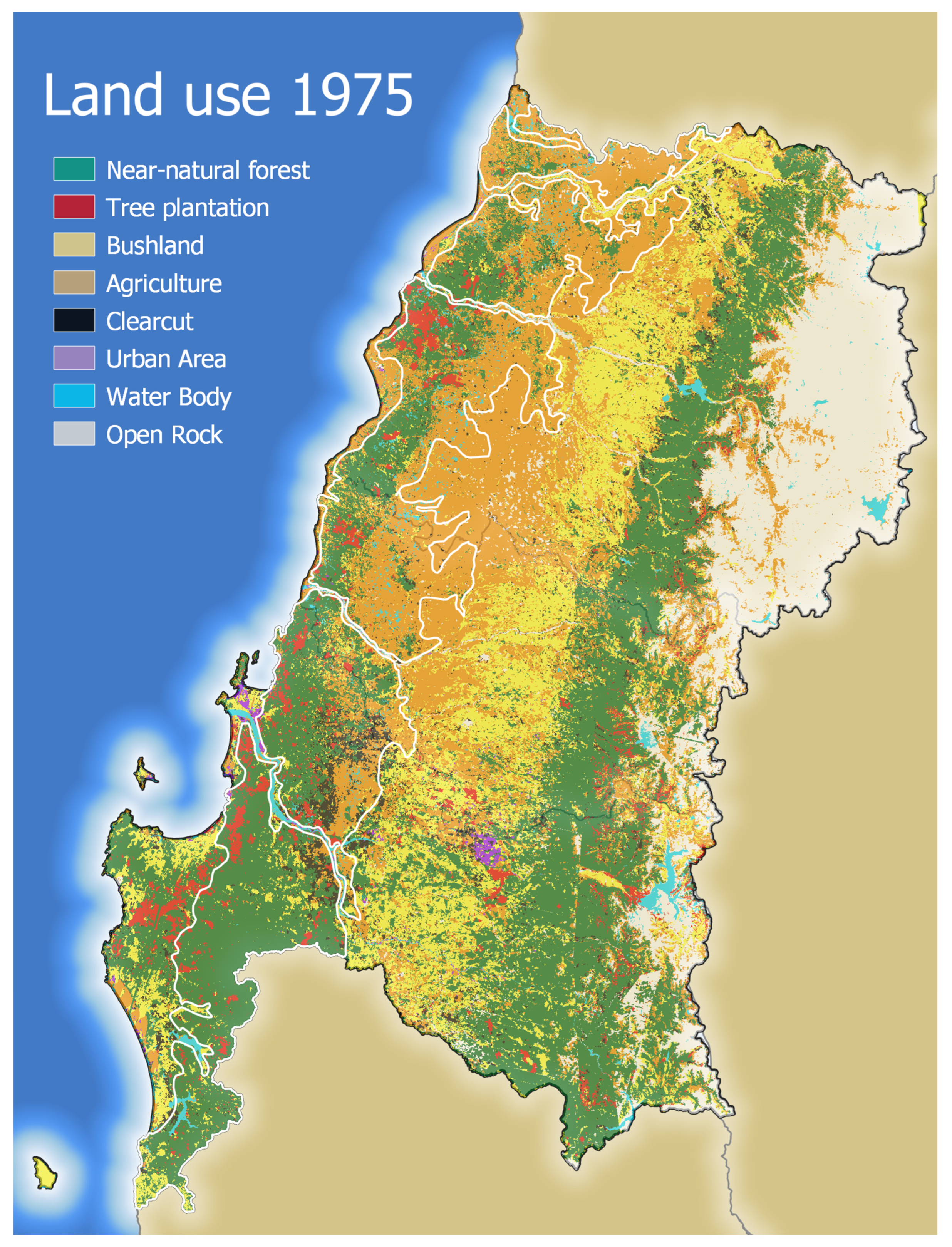
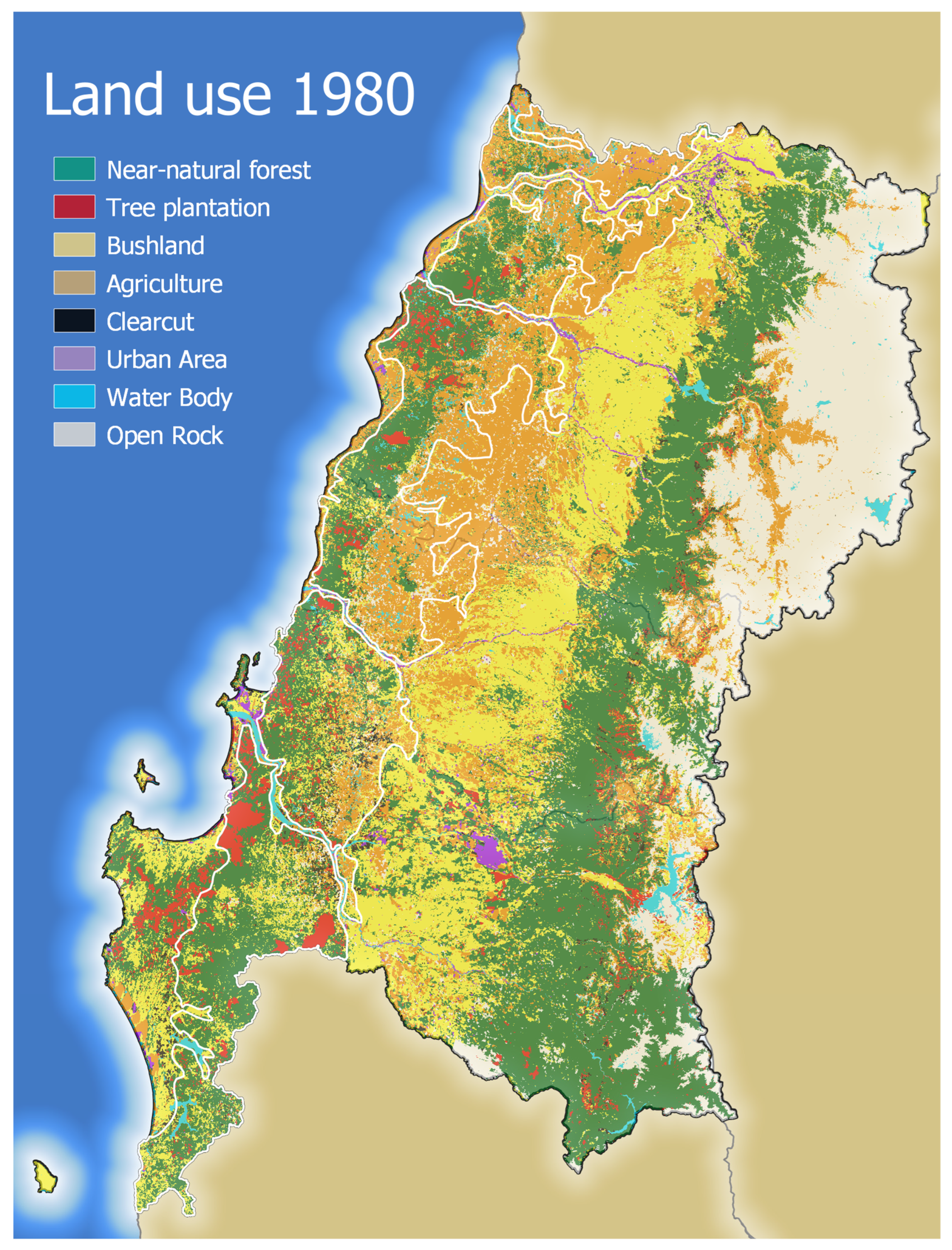
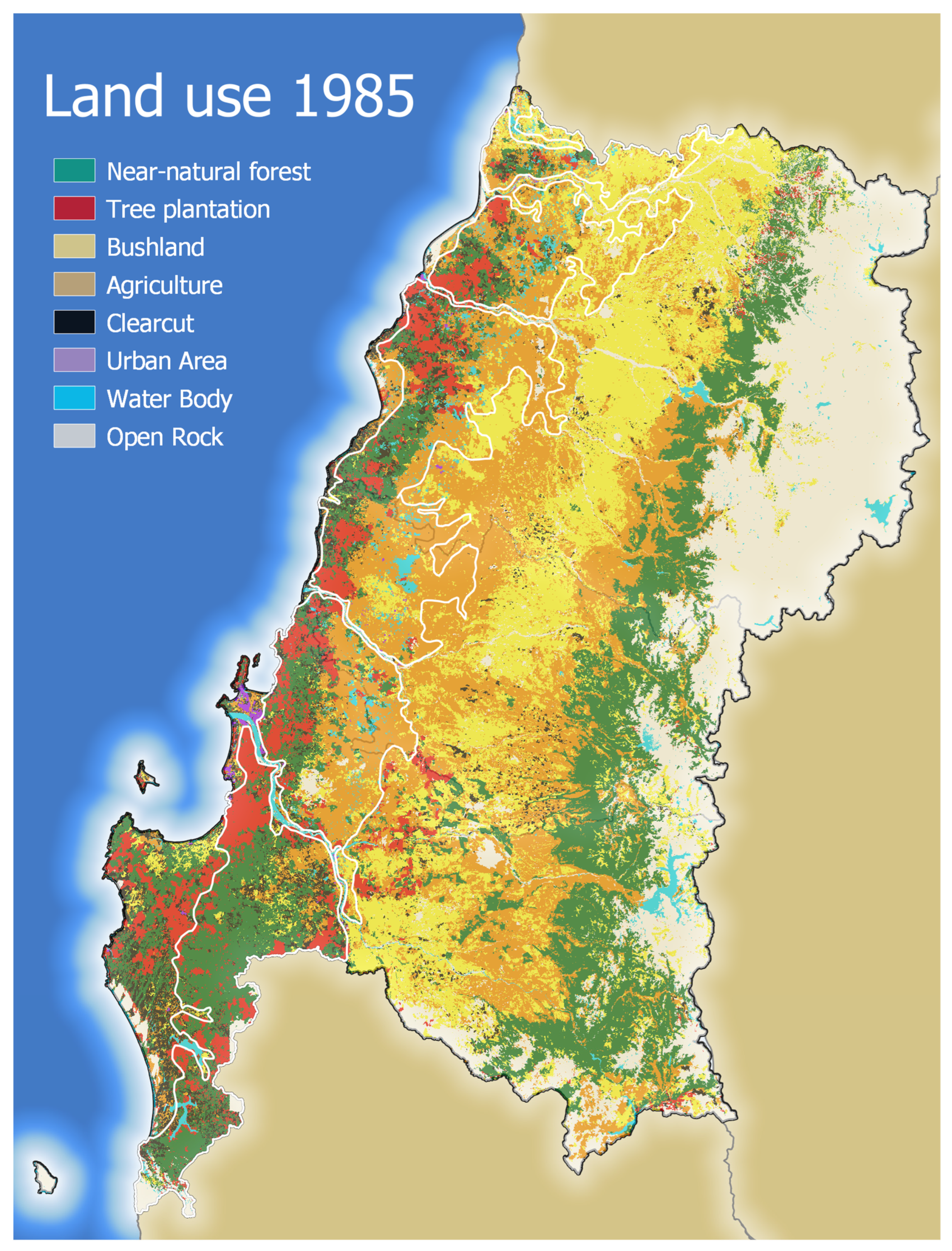
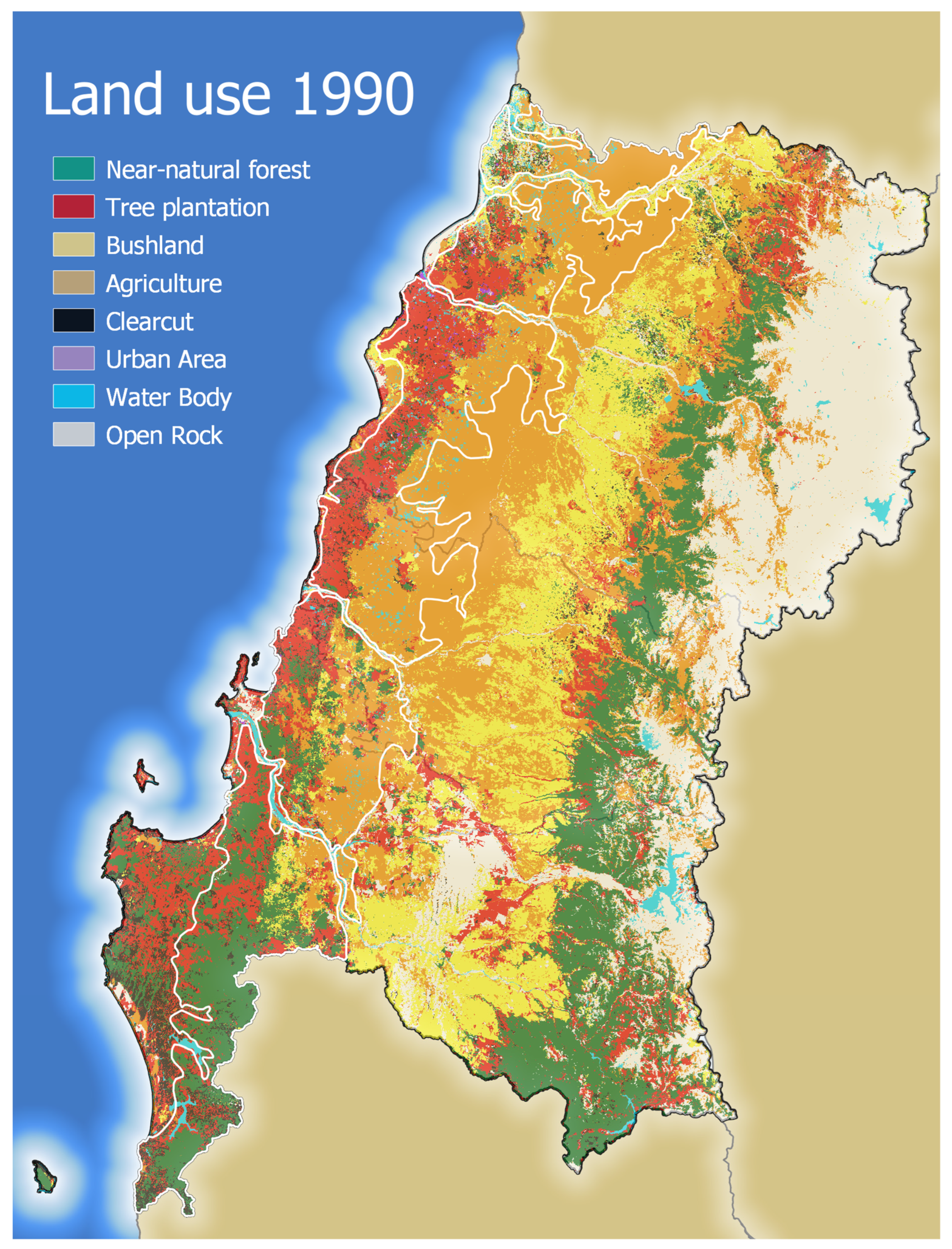
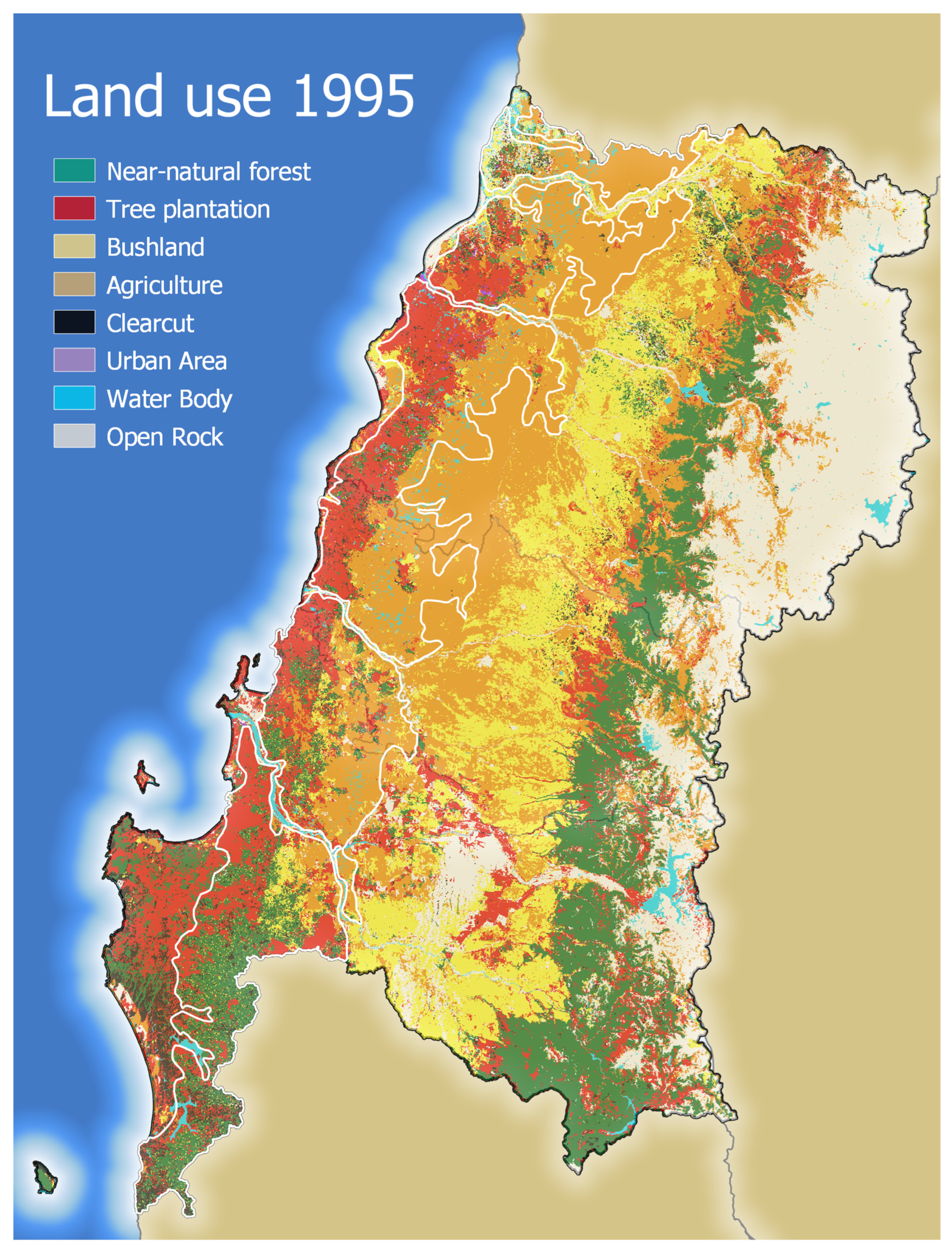

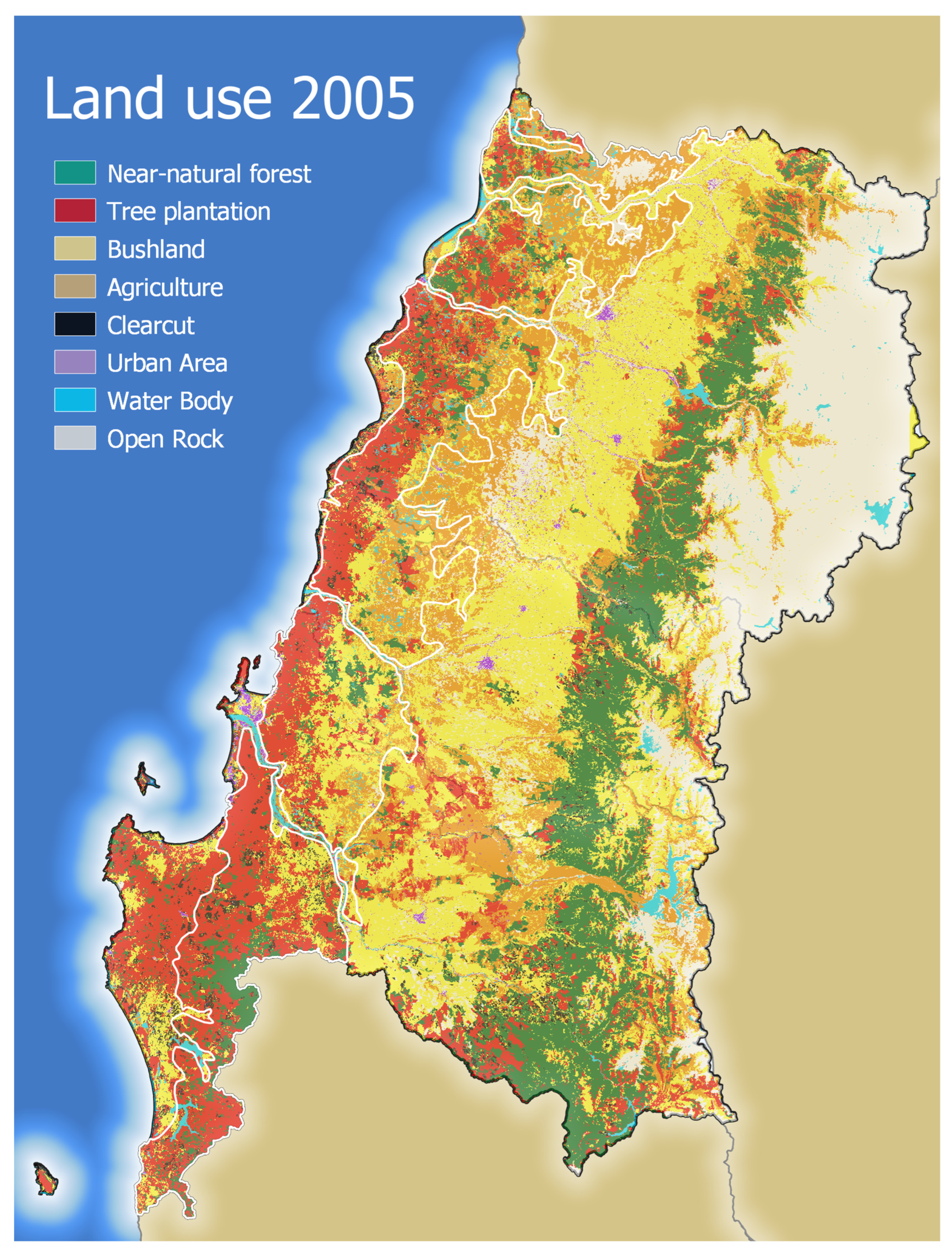
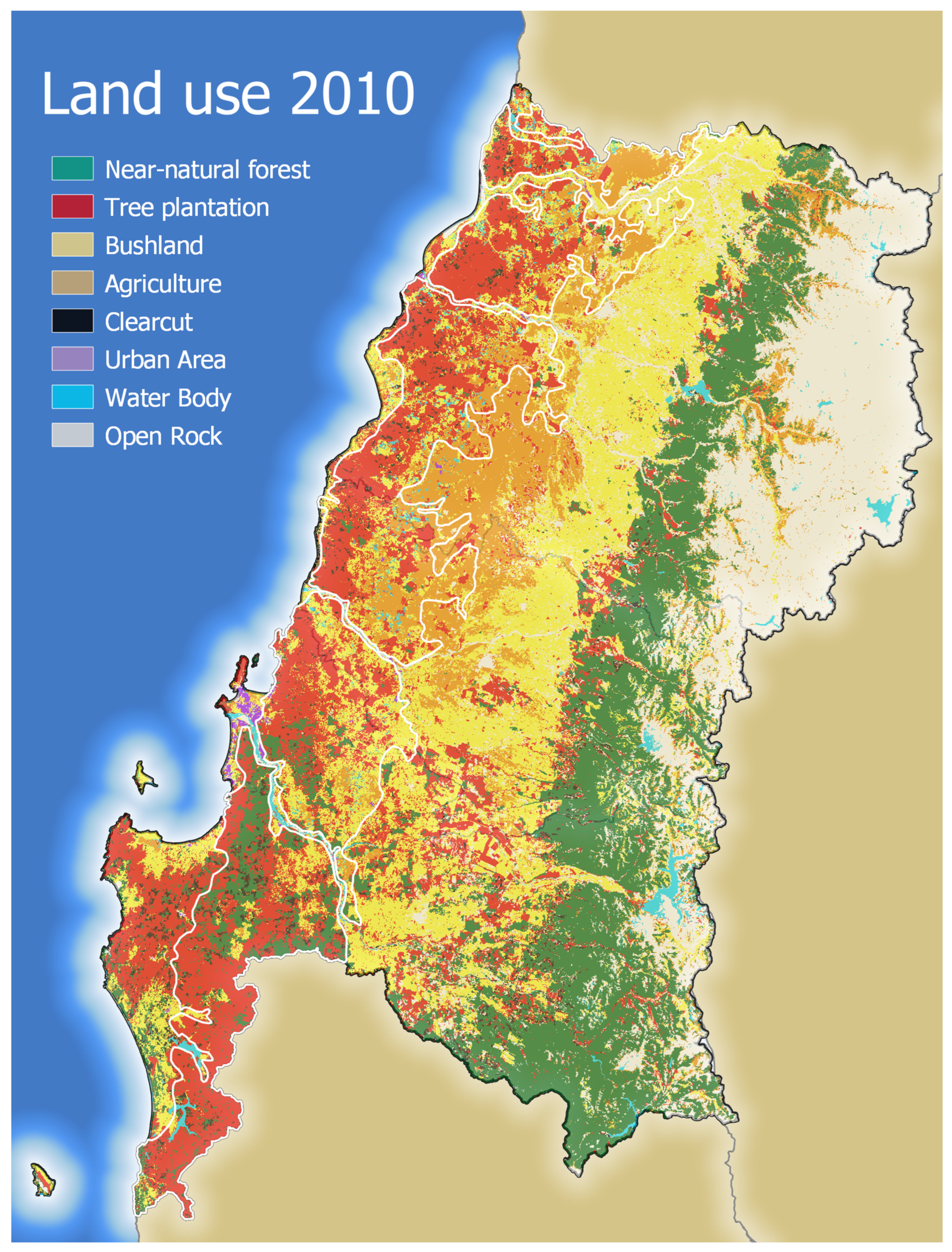
Appendix F
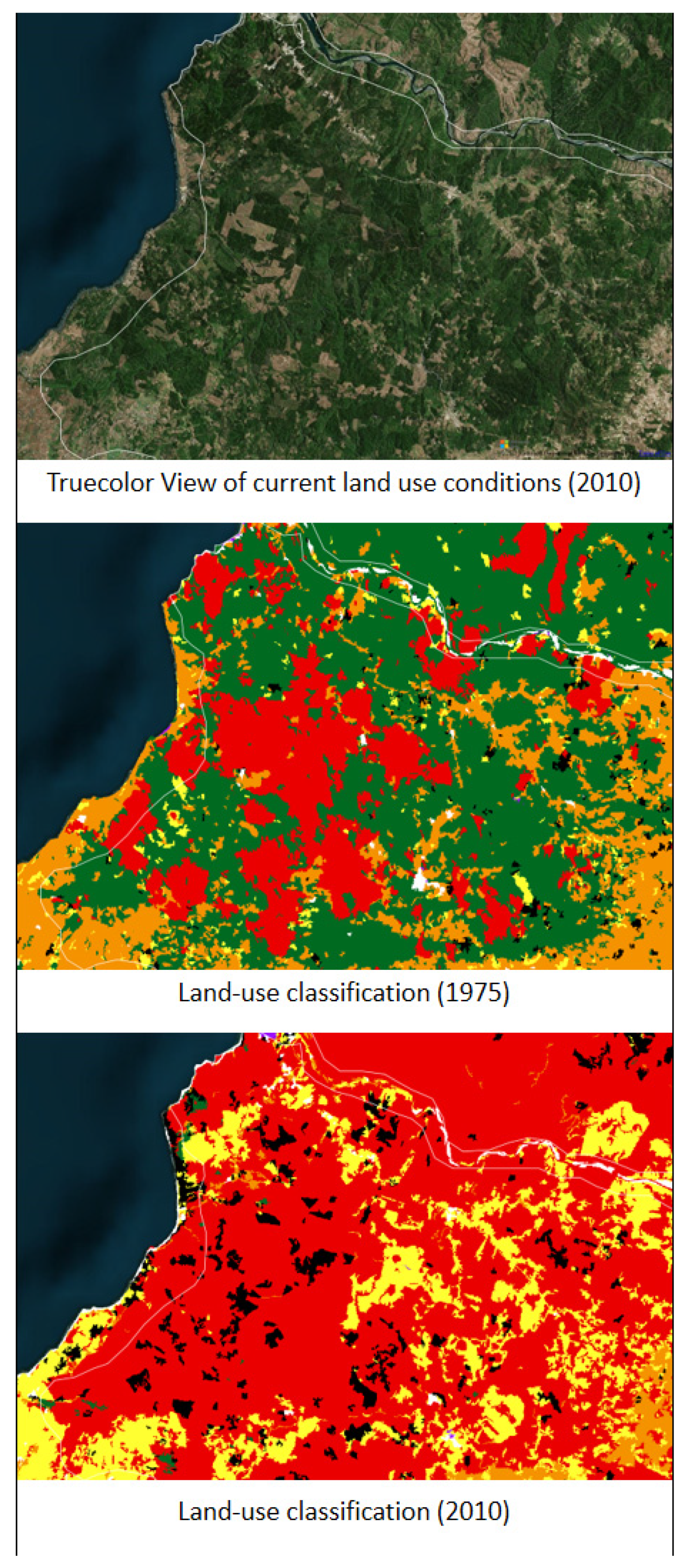
References
- Song, X.-P.; Hansen, M.C.; Stehman, S.V.; Potapov, P.V.; Tyukavina, A.; Vermote, E.F.; Townshend, J.R. Global land change from 1982 to 2016. Nature 2018, 560, 639–643. [Google Scholar] [CrossRef] [PubMed]
- Turner, B.L. Local faces, global flows: The role of land use and land cover in global environmental change. Land Degrad. Dev. 1994, 5, 71–78. [Google Scholar] [CrossRef]
- Dirmeyer, P.; Niyogi, D.; De Noblet-Ducoudré, N.; Dickinson, R.E.; Snyder, P.K. Impacts of land use change on climate. Int. J. Clim. 2010, 30, 1905–1907. [Google Scholar] [CrossRef] [Green Version]
- Pouyat, R.V.; Pataki, D.E.; Belt, K.T.; Groffman, P.M.; Hom, J.; Band, L.E. Effects of urban land-use change on biogeochemical cycles. In Terrestrial Ecosystems in a Changing World; Springer: Berlin/Heidelberg, Germany, 2007; pp. 45–58. [Google Scholar] [CrossRef]
- De Jong, L.; De Bruin, S.; Knoop, J.; van Vliet, J. Understanding land-use change conflict: A systematic review of case studies. J. Land Use Sci. 2021, 16, 223–239. [Google Scholar] [CrossRef]
- Sloan, S.; Sayer, J.A. Forest Resources Assessment of 2015 shows positive global trends but forest loss and degradation persist in poor tropical countries. For. Ecol. Manag. 2015, 352, 134–145. [Google Scholar] [CrossRef] [Green Version]
- Buongiorno, J.; Zhu, S. Assessing the impact of planted forests on the global forest economy. N. Zeal. J. For. Sci. 2014, 44, S2. [Google Scholar] [CrossRef] [Green Version]
- Doelman, J.C.; Stehfest, E.; van Vuuren, D.P.; Tabeau, A.; Hof, A.F.; Braakhekke, M.C.; Gernaat, D.E.H.J.; Berg, M.V.D.; van Zeist, W.; Daioglou, V.; et al. Afforestation for climate change mitigation: Potentials, risks and trade-offs. Glob. Chang. Biol. 2019, 26, 1576–1591. [Google Scholar] [CrossRef]
- Payn, T.; Carnus, J.-M.; Freer-Smith, P.; Kimberley, M.; Kollert, W.; Liu, S.; Orazio, C.; Rodriguez, L.; Silva, L.N.; Wingfield, M.J. Changes in planted forests and future global implications. For. Ecol. Manag. 2015, 352, 57–67. [Google Scholar] [CrossRef] [Green Version]
- Schirmer, J. Plantations and social conflict: Exploring the differences between small-scale and large-scale plantation forestry. Small Scale For. 2007, 6, 19–33. [Google Scholar] [CrossRef]
- Gerber, J.-F. Conflicts over industrial tree plantations in the South: Who, how and why? Glob. Environ. Chang. 2011, 21, 165–176. [Google Scholar] [CrossRef]
- Malkamäki, A.; D’Amato, D.; Hogarth, N.; Kanninen, M.; Pirard, R.; Toppinen, A.; Zhou, W. A systematic review of the socio-economic impacts of large-scale tree plantations, worldwide. Glob. Environ. Chang. 2018, 53, 90–103. [Google Scholar] [CrossRef]
- Valduga, M.O.; Zenni, R.D.; Vitule, J.R. Ecological impacts of non-native tree species plantations are broad and heterogeneous: A review of Brazilian research. An. Da Acad. Bras. De Ciências 2016, 88, 1675–1688. [Google Scholar] [CrossRef] [PubMed] [Green Version]
- Dodet, M.; Collet, C. When should exotic forest plantation tree species be considered as an invasive threat and how should we treat them? Biol. Invasions 2012, 14, 1765–1778. [Google Scholar] [CrossRef]
- Farley, K.A.; Jobbagy, E.G.; Jackson, R.B. Effects of afforestation on water yield: A global synthesis with implications for policy. Glob. Chang. Biol. 2005, 11, 1565–1576. [Google Scholar] [CrossRef]
- Honegger, M.; Michaelowa, A.; Roy, J. Potential implications of carbon dioxide removal for the sustainable development goals. Clim. Policy 2020, 21, 678–698. [Google Scholar] [CrossRef]
- Bull, G.Q.; Bazett, M.; Schwab, O.; Nilsson, S.; White, A.; Maginnis, S. Industrial forest plantation subsidies: Impacts and implications. For. Policy Econ. 2006, 9, 13–31. [Google Scholar] [CrossRef]
- Clapp, R.A. The Unnatural History of the Monterey Pine. Geogr. Rev. 1995, 85, 1–19. [Google Scholar] [CrossRef]
- Hofflinger, A.; Nahuelpan, H.; Boso, À.; Millalen, P. Do Large-Scale Forestry Companies Generate Prosperity in Indigenous Communities? The Socioeconomic Impacts of Tree Plantations in Southern Chile. Hum. Ecol. 2021, 49, 619–630. [Google Scholar] [CrossRef]
- Clapp, R.A. Creating Competitive Advantage: Forest Policy as Industrial Policy in Chile. Econ. Geogr. 1995, 71, 273. [Google Scholar] [CrossRef]
- Langenfeld, M. Waldpolitik in Costa Rica und Chile; Springer: Fachmedien, Wiesbaden, 2017. [Google Scholar] [CrossRef]
- Grez, A.; Bustamante, R.; Simonetti, J.; Fahrig, L. Landscape Ecology, Deforestation, and forEst Fragmentation: The Case of the Ruil Forest in Chile: Landscape Ecology as a Tool for Sustainable Development in Latin America. 1998. Available online: https://www.researchgate.net/profile/aa-grez/publication/254319278_landscape_ecology_deforestation_and_forest_fragmentation_the_case_of_the_ruil_forest_in_chile/links/54c91abb0cf2595d6c7dfae5/landscape-ecology-deforestation-and-forest-fragmentation-the-case-of-the-ruil-forest-in-chile.pdf (accessed on 12 May 2021).
- Lara, A.; Urrutia, R.; Little, C.; Martinez, A. Servicios ecosistémicos y ley del bosque nativo: No basta con definirlos. Rev. Bosque Nativ. 2010, 47, 3–9. [Google Scholar]
- Tricallotis, M. ¿En qué contexto surge la certificación forestal en Chile?: Desempeño ambiental, social y económico de empresas no certificadas. Bosque 2016, 37, 613–624. [Google Scholar] [CrossRef] [Green Version]
- Clapp, R.A. Tree Farming and Forest Conservation in Chile: Do Replacement Forests Leave Any Originals Behind? Soc. Nat. Resour. 2001, 14, 341–356. [Google Scholar] [CrossRef]
- Aguayo, M.; Pauchard, A.; Azocar, G.; Parra, O. Land use change in the south central Chile at the end of the 20th century: Understanding the spatio-temporal dynamics of the landscape. Rev. Chil. De Hist. Nat. 2003, 82, 361–374. [Google Scholar]
- Echeverria, C.; Coomes, D.; Salas, J.; Benayas, J.R.; Lara, A.; Newton, A. Rapid deforestation and fragmentation of Chilean Temperate Forests. Biol. Conserv. 2006, 130, 481–494. [Google Scholar] [CrossRef]
- Schulz, J.J.; Cayuela, L.; Echeverria, C.; Salas, J.; Rey Benayas, J.M. Monitoring land cover change of the dryland forest landscape of Central Chile (1975–2008). Appl. Geogr. 2010, 30, 436–447. [Google Scholar] [CrossRef] [Green Version]
- Vergara, P.M.; Pérez-Hernández, C.G.; Hahn, I.J.; Soto, G.E. Deforestation in central Chile causes a rapid decline in landscape connectivity for a forest specialist bird species. Ecol. Res. 2013, 28, 481–492. [Google Scholar] [CrossRef]
- Altamirano, A.; Lara, A. Deforestation in temperate ecosystems of pre-Andean range of south-central Chile. Bosque 2010, 31, 53–64. [Google Scholar]
- Altamirano, A.; Aplin, P.; Miranda, A.; Cayuela, L.; Algar, A.C.; Field, R. High rates of forest loss and turnover obscured by classical landscape measures. Appl. Geogr. 2013, 40, 199–211. [Google Scholar] [CrossRef]
- Miranda, A.; Altamirano, A.; Cayuela, L.; Pincheira, F.; Lara, A. Different times, same story: Native forest loss and landscape homogenization in three physiographical areas of south-central of Chile. Appl. Geogr. 2015, 60, 20–28. [Google Scholar] [CrossRef]
- Zamorano-Elgueta, C.; Benayas, J.R.; Cayuela, L.; Hantson, S.; Armenteras, D. Native forest replacement by exotic plantations in southern Chile (1985–2011) and partial compensation by natural regeneration. For. Ecol. Manag. 2015, 345, 10–20. [Google Scholar] [CrossRef] [Green Version]
- Echeverría, C.; Newton, A.; Nahuelhual, L.; Coomes, D.; Benayas, J.R. How landscapes change: Integration of spatial patterns and human processes in temperate landscapes of southern Chile. Appl. Geogr. 2012, 32, 822–831. [Google Scholar] [CrossRef]
- Heilmayr, R.; Echeverría, C.; Fuentes, R.; Lambin, E.F. A plantation-dominated forest transition in Chile. Appl. Geogr. 2016, 75, 71–82. [Google Scholar] [CrossRef] [Green Version]
- Mather, A.S. The forest transition. Area 1992, 367–379. Available online: https://www.jstor.org/stable/20003181 (accessed on 12 May 2021).
- Uribe, S.V.; Estades, C.; Radeloff, V.C. Pine plantations and five decades of land use change in central Chile. PLoS ONE 2020, 15, e0230193. [Google Scholar] [CrossRef] [Green Version]
- Nahuelhual, L.; Carmona, A.; Lara, A.; Echeverría, C.; González, M.E. Land-cover change to forest plantations: Proximate causes and implications for the landscape in south-central Chile. Landsc. Urban Plan. 2012, 107, 12–20. [Google Scholar] [CrossRef] [Green Version]
- Miranda, A.; Altamirano, A.; Cayuela, L.; Lara, A.; González, M. Native forest loss in the Chilean biodiversity hotspot: Revealing the evidence. Reg. Environ. Chang. 2016, 17, 285–297. [Google Scholar] [CrossRef]
- Lanfranco, D.; Dungey, H.S. Insect damage in Eucalyptus: A review of plantations in Chile. Austral Ecol. 2001, 26, 477–481. [Google Scholar] [CrossRef]
- Lara, A.; Jones, J.; Little, C.; Vergara, N. Streamflow response to native forest restoration in former Eucalyptus plantations in south central Chile. Hydrol. Process. 2021, 35, e14270. [Google Scholar] [CrossRef]
- Huber, A.; Iroumé, A.; Mohr, C.; Frêne, C. Efecto de plantaciones de Pinus radiata y Eucalyptus globulus sobre el recurso agua en la Cordillera de la Costa de la región del Biobío, Chile. Bosque 2010, 31, 219–230. [Google Scholar] [CrossRef]
- McWethy, D.B.; Pauchard, A.; García, R.A.; Holz, A.; González, M.E.; Veblen, T.T.; Stahl, J.; Currey, B. Landscape drivers of recent fire activity (2001–2017) in south-central Chile. PLoS ONE 2018, 13, e0201195. [Google Scholar] [CrossRef]
- Garreaud, R.D.; Boisier, J.P.; Rondanelli, R.; Montecinos, A.; Sepúlveda, H.H.; Veloso-Aguila, D. The Central Chile Mega Drought (2010–2018): A climate dynamics perspective. Int. J. Clim. 2019, 40, 421–439. [Google Scholar] [CrossRef]
- Braun, A.C.; Faßnacht, F.; Valencia, D.; Sepulveda, M. Consequences of land-use change and the wildfire disaster of 2017 for the central Chilean biodiversity hotspot. Reg. Environ. Chang. 2021, 21, 1–22. [Google Scholar] [CrossRef]
- Liu, X.; Andersson, C. Assessing the impact of temporal dynamics on land-use change modeling. Comput. Environ. Urban Syst. 2004, 28, 107–124. [Google Scholar] [CrossRef]
- Mas, J.-F.; De Vasconcelos, R.N.; Franca-Rocha, W. Analysis of High Temporal Resolution Land Use/Land Cover Trajectories. Land 2019, 8, 30. [Google Scholar] [CrossRef] [Green Version]
- Toro, J.; Gessel, S. Radiata pine plantations in Chile. New For. 1999, 18, 33–44. [Google Scholar] [CrossRef]
- Braun, A.C. More accurate less meaningful? A critical physical geographer’s reflection on interpreting remote sensing land-use analyses. Prog. Phys. Geogr. Earth Environ. 2021, 45, 706–735. [Google Scholar] [CrossRef]
- Braun, A.C.; Rojas, C.; Echeverria, C.; Rottensteiner, F.; Bahr, H.-P.; Niemeyer, J.; Arias, M.A.; Kosov, S.; Hinz, S.; Weidner, U. Design of a Spectral–Spatial Pattern Recognition Framework for Risk Assessments Using Landsat Data—A Case Study in Chile. IEEE J. Sel. Top. Appl. Earth Obs. Remote Sens. 2014, 7, 917–928. [Google Scholar] [CrossRef]
- Shao, G.; Wu, J. On the accuracy of landscape pattern analysis using remote sensing data. Landsc. Ecol. 2008, 23, 505–511. [Google Scholar] [CrossRef]
- Camus Gayan, P. De la panacea a la tragedia. Bosques, erosión y forestación en Chile. Siglos XIX y XX. HIB: Rev. De Hist. Iberoam. 2014, 7, 1. [Google Scholar] [CrossRef]
- Modrego, F.; Barrera, D.; Charnay, R. Estimacion del effecto del decreto ley N 701 de fomento forestal so-bre las tasas de forestación en Chile: Un análisis a nivel regional. Working Paper 2004. Available online: https://www.rimisp.org/wp-content/files_mf/135937542015.pdf (accessed on 12 May 2021).
- Altieri, M.A.; Rojas, A. Ecological Impacts of Chile’s Neoliberal Policies, with Special Emphasis on Agroecosystems. Environ. Dev. Sustain. 1999, 1, 55–72. [Google Scholar] [CrossRef]
- Asmüssen, M.V.; Simonetti, J.A. Can a developing country like Chile invest in biodiversity conservation? Environ. Conserv. 2007, 34, 183–185. [Google Scholar] [CrossRef]
- Banfield, C.C.; Braun, A.C.; Barra, R.; Castillo, A.; Vogt, J. Erosion proxies in an exotic tree plantation question the appropriate land use in Central Chile. CATENA 2018, 161, 77–84. [Google Scholar] [CrossRef]
- Aburto, F.; Cartes, E.; Mardones, O.; Rubilar, R. Hillslope soil erosion and mobility in pine plantations and native deciduous forest in the coastal range of south-Central Chile. Land Degrad. Dev. 2020, 32, 453–466. [Google Scholar] [CrossRef]
- Van Holt, T.; Moreno, C.A.; Binford, M.W.; Portier, K.M.; Mulsow, S.; Frazer, T.K. Influence of landscape change on nearshore fisheries in southern Chile. Glob. Chang. Biol. 2012, 18, 2147–2160. [Google Scholar] [CrossRef]
- Andersson, K.; Lawrence, D.; Zavaleta, J.; Guariguata, M.R. More Trees, More Poverty? The Socioeconomic Effects of Tree Plantations in Chile, 2001–2011. Environ. Manag. 2015, 57, 123–136. [Google Scholar] [CrossRef] [Green Version]
- Braun, A.C. Encroached by pine and eucalyptus? A grounded theory on an environmental conflict between forest industry and smallholder livelihoods in Chile. J. Rural Stud. 2021, 82, 107–120. [Google Scholar] [CrossRef]
- Lewis, S.L.; Wheeler, C.E.; Mitchard, E.T.A.; Koch, A. Restoring natural forests is the best way to remove atmospheric carbon. Nature 2019, 568, 25–28. [Google Scholar] [CrossRef]
- Braun, A.C.; Weidner, U.; Hinz, S. Classification in High-Dimensional Feature Spaces—Assessment Using SVM, IVM and RVM With Focus on Simulated EnMAP Data. IEEE J. Sel. Top. Appl. Earth Obs. Remote Sens. 2012, 5, 436–443. [Google Scholar] [CrossRef]
- Braun, A.C.; Weidner, U.; Hinz, S. Support Vector Machines for Vegetation Classification A Revision. Photogramm. Fernerkund. Geoinf. 2010, 2010, 273–281. [Google Scholar] [CrossRef]
- Urrutia-Jalabert, R.; Gonzalez, M.; González-Reyes, Á.; Lara, A.; Garreaud, R. Climate variability and forest fires in central and south-central Chile. Ecosphere 2018, 9, 1–17. [Google Scholar] [CrossRef]
- Acuña, E.; Sanfuentes, E.; Cancino, J.; Mena, P. Damage to remaining trees by four systems of mechanized harvest in commercial thinning of Pinus radiata. Ciência Florest. 2018, 28, 1317–1327. [Google Scholar] [CrossRef] [Green Version]
- UNECE/FAO. Chile’s Forest Products Markets-a Plantation Success Story. 2002. Available online: https://scholar.google.de/citations?user=znihdekaaaaj&hl=de&oi=sra (accessed on 12 May 2021).
- Salas-Eljatib, C.; Donoso, P.J.; Vargas, R.; Arriagada, C.A.; Pedraza, R.; Soto, D.P. The Forest Sector in Chile: An Overview and Current Challenges. J. For. 2016, 114, 562–571. [Google Scholar] [CrossRef] [Green Version]
- Cerda, R.; Gallardo-Cobos, R.; Sánchez-Zamora, P. An Analysis of the Impact of Forest Policy on Rural Areas of Chile. Forests 2020, 11, 1105. [Google Scholar] [CrossRef]
- Richter, R.; Schläpfer, D. Atmospheric and Topographic Correction (ATCOR Theoretical Background Document). DLR IB 2019, 564-03. Available online: http://www.rese-apps.com/pdf/atcor_atbd.pdf (accessed on 12 May 2021).
- Slater, J.A.; Heady, B.; Kroenung, G.; Curtis, W.; Haase, J.; Hoegemann, D.; Shockley, C.; Tracy, K. Global Assessment of the New ASTER Global Digital Elevation Model: American Society for Pho-togrammetry and Remote Sensing. Photogramm. Eng. Remote Sens. 2011, 77, 335–349. Available online: https://www.ingentaconnect.com/content/asprs/pers/2011/00000077/00000004/art00002 (accessed on 12 May 2021). [CrossRef]
- Weidner, U. Toward a framework for quality assessment in remote sensing applications. In Object and Pat-tern Recognition in Remote Sensing-Modelling and Monitoring Enviromental and Anthropogenic Objects and Change Processes; Hinz, S., Braun, A., Weinmann, M., Eds.; Whittles Publishing: Dunbeath, Scotland, 2021. [Google Scholar]
- Kraemer, H.C. Kappa Coefficient. In Wiley StatsRef: Statistics Reference Online; John Wiley & Sons, Ltd.: Hoboken, NJ, USA, 2015; pp. 1–4. [Google Scholar]
- Kattenborn, T.; Lopatin, J.; Förster, M.; Braun, A.C.; Fassnacht, F.E. UAV data as alternative to field sampling to map woody invasive species based on combined Sentinel-1 and Sentinel-2 data. Remote Sens. Environ. 2019, 227, 61–73. [Google Scholar] [CrossRef]
- Xie, Y.; Sha, Z.; Yu, M. Remote sensing imagery in vegetation mapping: A review. J. Plant Ecol. 2008, 1, 9–23. [Google Scholar] [CrossRef]
- Shoshany, M. Satellite remote sensing of natural Mediterranean vegetation: A review within an ecological context. Prog. Phys. Geogr. Earth Environ. 2000, 24, 153–178. [Google Scholar] [CrossRef]
- Kattenborn, T.; Leitloff, J.; Schiefer, F.; Hinz, S. Review on Convolutional Neural Networks (CNN) in vegetation remote sensing. ISPRS J. Photogramm. Remote Sens. 2021, 173, 24–49. [Google Scholar] [CrossRef]
- Fu, Y.; Zhao, C.; Wang, J.; Jia, X.; Yang, G.; Song, X.; Feng, H. An Improved Combination of Spectral and Spatial Features for Vegetation Classification in Hyperspectral Images. Remote Sens. 2017, 9, 261. [Google Scholar] [CrossRef] [Green Version]
- Ashoori, H.; Zoej, M.J.V.; Sahebi, M.R. Introduction of Spatio-Spectral Indices for Using Spatial Data in Multispectral Image Classification. J. Indian Soc. Remote Sens. 2019, 47, 1003–1017. [Google Scholar] [CrossRef]
- Object and Pattern Recognition in Remote Sensing-Modelling and Monitoring Enviromental and Anthropogenic Objects and Change Processes; Stefan, H.; Andreas, B.; Martin, W. (Eds.) Whittles Publishing: Dunbeath, Scotland, 2021; Available online: https://www.whittlespublishing.com/Object_and_Pattern_Recognition_in_Remote_Sensing_ (accessed on 12 May 2021).
- Fauvel, M.; Tarabalka, Y.; Benediktsson, J.A.; Chanussot, J.; Tilton, J.C. Advances in spectral-spatial classification of hyperspectral images. Proc. IEEE 2013, 101, 652–675. [Google Scholar] [CrossRef] [Green Version]
- Jimenez, L.; Landgrebe, D. Supervised classification in high-dimensional space: Geometrical, statistical, and asymptotical properties of multivariate data. IEEE Trans. Syst. Man Cybern. Part C Appl. Rev. 1998, 28, 39–54. [Google Scholar] [CrossRef]
- Altman, N.; Krzywinski, M. The curse(s) of dimensionality. Nat. Methods 2018, 15, 399–400. [Google Scholar] [CrossRef]
- Dalla Mura, M.; Benediktsson, J.A.; Waske, B.; Bruzzone, L. Morphological Attribute Profiles for the Analysis of Very High Resolution Images. IEEE Trans. Geosci. Remote Sens. 2010, 48, 3747–3762. [Google Scholar] [CrossRef]
- Whitley, D.C.; Ford, M.G.; Livingstone, D.J. Unsupervised Forward Selection: A Method for Eliminating Redundant Variables. J. Chem. Inf. Comput. Sci. 2000, 40, 1160–1168. [Google Scholar] [CrossRef] [PubMed]
- Yu, S.; Tranchevent, L.-C.; De Moor, B.; Moreau, Y. Kernel-Based Data Fusion for Machine Learning; Springer: Berlin, Germany, 2011. [Google Scholar]
- Braun, A.C.; Weidner, U.; Jutzi, B.; Hinz, S. Verknüpfung von Kernfunktionen mit der eins-gegen-eins Kaskade für die Einbindung von Wissen in die SVM Klassifizierung. Photogramm Fernerkund. Geoinf. 2012, 2012, 371–384. [Google Scholar] [CrossRef]
- Lee, W.-J.; Verzakov, S.; Duin, R.P. Kernel combination versus classifier combination. In International Workshop on Multiple Classifier Systems; Springer: Berlin/Heidelberg, Germany, 2007; Volume 4472, pp. 22–31. [Google Scholar]
- Szafranski, M.; Grandvalet, Y.; Rakotomamonjy, A. Composite kernel learning. Mach. Learn. 2009, 79, 73–103. [Google Scholar] [CrossRef] [Green Version]
- Braun, A.C.; Weidner, U.; Jutzi, B.; Hinz, S. Integrating external knowledge into SVM classification—Fusing hyperspectral and laserscanning data by kernel composition. ISPRS Int. Arch. Photogramm. Remote Sens. Spat. Inf. Sci. 2012, XXXVIII-4, 57–62. [Google Scholar] [CrossRef] [Green Version]
- Braun, A.C.; Weidner, U.; Hinz, S. Classifying roof materials using data fusion through kernel composi-tion—Comparing ν-SVM and one-class SVM. In Proceedings of the 2011 Joint Urban Remote Sensing Event, Munich, Germany, 11–13 April 2011; pp. 377–380. [Google Scholar]
- Camps-Valls, G.; Bruzzone, L. Kernel Methods for Remote Sensing Data Analysis; Wiley: West Sussex, UK, 2009. [Google Scholar]
- Wolpert, D.H.; Macready, W.G. No free lunch theorems for optimization. IEEE Trans. Evol. Comput. 1997, 1, 67–82. [Google Scholar] [CrossRef] [Green Version]
- Briem, G.; Benediktsson, J.A.; Sveinsson, J.R. Multiple classifiers applied to multisource remote sensing data. IEEE Trans. Geosci. Remote Sens. 2002, 40, 2291–2299. [Google Scholar] [CrossRef] [Green Version]
- Boser, B.E.; Guyon, I.M.; Vapnik, V.N. A training algorithm for optimal margin classifiers. In Proceedings of the Fifth Annual Workshop on Computational Learning Theory-COLT ‘92, New York, NY, USA, 27–29 July 1992. [Google Scholar]
- Zhu, J.; Hastie, T. Kernel Logistic Regression and the Import Vector Machine. J. Comput. Graph. Stat. 2005, 14, 185–205. [Google Scholar] [CrossRef]
- Tipping, M.E. Sparse Bayesian learning and the relevance vector machine. J. Mach. Learn. Re Search 2001, 1, 211–244. Available online: https://www.jmlr.org/papers/volume1/tipping01a/tipping01a.pdf (accessed on 12 May 2021).
- Chang, C.; Lin, C. LIBSVM: A Library for Support Vector Machines. ACM Trans. Intell. Syst. Technol. 2013, 2, 1–39. [Google Scholar] [CrossRef]
- Roscher, R.; Förstner, W.; Waske, B. I2VM: Incremental import vector machines. Image Vis. Comput. 2012, 30, 263–278. [Google Scholar] [CrossRef]
- Puyravaud, J.-P. Standardizing the calculation of the annual rate of deforestation. For. Ecol. Manag. 2003, 177, 593–596. [Google Scholar] [CrossRef]
- Salah, M.; Trinder, J.C.; Shaker, A.; Hamed, B.; Elsagheer, B. Integrating Multiple Classifiers with Fuzzy Majority Voting for Improved Land cover Classification. Available online: http://citeseerx.ist.psu.edu/viewdoc/summary?doi=10.1.1.367.2418 (accessed on 12 May 2021).
- Cohen, W.B.; Goward, S.N. Landsat’s Role in Ecological Applications of Remote Sensing. BioScience 2004, 54, 535. [Google Scholar] [CrossRef]
- Niemeyer, J.; Rottensteiner, F.; Soergel, U. Classification of urban LiDAR data using conditional random field and random forests. In Proceedings of the Joint Urban Remote Sensing Event, Sao Paolo, Brazil, 21–23 April 2013; pp. 139–142. [Google Scholar]
- Wang, M.; Zhang, H.; Sun, W.; Li, S.; Wang, F.; Yang, G. A Coarse-to-Fine Deep Learning Based Land Use Change Detection Method for High-Resolution Remote Sensing Images. Remote Sens. 2020, 12, 1933. [Google Scholar] [CrossRef]
- Mu, L.; Wang, L.; Wang, Y.; Chen, X.; Han, W. Urban Land Use and Land Cover Change Prediction via Self-Adaptive Cellular Based Deep Learning With Multisourced Data. IEEE J. Sel. Top. Appl. Earth Obs. Remote Sens. 2019, 12, 5233–5247. [Google Scholar] [CrossRef]
- Jozdani, S.E.; Johnson, B.A.; Chen, D. Comparing Deep Neural Networks, Ensemble Classifiers, and Support Vector Machine Algorithms for Object-Based Urban Land Use/Land Cover Classification. Remote Sens. 2019, 11, 1713. [Google Scholar] [CrossRef] [Green Version]
- Liu, P.; Choo, K.-K.R.; Wang, L.; Huang, F. SVM or deep learning? A comparative study on remote sensing image classification. Soft Comput. 2016, 21, 7053–7065. [Google Scholar] [CrossRef]
- Hasan, H.; Shafri, H.Z.; Habshi, M. A Comparison Between Support Vector Machine (SVM) and Convolutional Neural Network (CNN) Models For Hyperspectral Image Classification. IOP Conf. Series Earth Environ. Sci. 2019, 357, 012035. [Google Scholar] [CrossRef] [Green Version]
- Heilmayr, R.; Echeverría, C.; Lambin, E.F. Impacts of Chilean forest subsidies on forest cover, carbon and biodiversity. Nat. Sustain 2020, 3, 701–709. [Google Scholar] [CrossRef]
- Pannell, D.J.; Roberts, A.M. Conducting and delivering integrated research to influence land-use policy: Salinity policy in Australia. Environ. Sci. Policy 2009, 12, 1088–1098. [Google Scholar] [CrossRef]
- Sohl, T.L.; Claggett, P.R. Clarity versus complexity: Land-use modeling as a practical tool for decision-makers. J. Environ. Manag. 2013, 129, 235–243. [Google Scholar] [CrossRef]
- De Oca, A.I.F.-M.; Gallardo-Cruz, J.A.; Ghilardi, A.; Kauffer, E.; Solórzano, J.V.; Sánchez-Cordero, V. An integrated framework for harmonizing definitions of deforestation. Environ. Sci. Policy 2020, 115, 71–78. [Google Scholar] [CrossRef]
- Van Holt, T.; Binford, M.W.; Portier, K.M.; Vergara, R. A stand of trees does not a forest make: Tree plantations and forest transitions. Land Use Policy 2016, 56, 147–157. [Google Scholar] [CrossRef]
- Gachet, S.; Leduc, A.; Bergeron, Y.; Nguyen-Xuan, T.; Tremblay, F. Understory vegetation of boreal tree plantations: Differences in relation to previous land use and natural forests. For. Ecol. Manag. 2007, 242, 49–57. [Google Scholar] [CrossRef]
- Komatsu, H.; Kume, T.; Otsuki, K. The effect of converting a native broad-leaved forest to a coniferous plantation forest on annual water yield: A paired-catchment study in northern Japan. For. Ecol. Manag. 2008, 255, 880–886. [Google Scholar] [CrossRef]
- Braun, A.C.; Troeger, D.; Garcia, R.; Aguayo, M.; Barra, R.; Vogt, J. Assessing the impact of plantation forestry on plant biodiversity. Glob. Ecol. Conserv. 2017, 10, 159–172. [Google Scholar] [CrossRef]
- Baruch, Z.; Nozawa, S.; Johnson, E.; Yerena, E. Ecosystem dynamics and services of a paired Neotropical montane forest and pine plantation. Rev. Biol. Trop. 2019, 67, 24–35. [Google Scholar] [CrossRef]
- Perz, S.G. Grand Theory and Context-Specificity in the Study of Forest Dynamics: Forest Transition Theory and Other Directions. Prof. Geogr. 2007, 59, 105–114. [Google Scholar] [CrossRef]
- Langdon, B.; Pauchard, A.; Aguayo, M. Pinus contorta invasion in the Chilean Patagonia: Local patterns in a global context. Biol. Invasions 2010, 12, 3961–3971. [Google Scholar] [CrossRef]
- Paritsis, J.; Landesmann, J.B.; Kitzberger, T.; Tiribelli, F.; Sasal, Y.; Quintero, C.; DiMarco, R.D.; Barrios-García, M.N.; Iglesias, A.L.; Diez, J.P.; et al. Pine Plantations and Invasion Alter Fuel Structure and Potential Fire Behavior in a Patagonian Forest-Steppe Ecotone. Forests 2018, 9, 117. [Google Scholar] [CrossRef] [Green Version]
- Myers, N.; Mittermeier, R.A.; Mittermeier, C.G.; da Fonseca, G.A.B.; Kent, J. Biodiversity hotspots for conservation priorities. Nature 2000, 403, 853–858. [Google Scholar] [CrossRef] [PubMed]
- Rockström, J.; Steffen, W.; Noone, K.; Persson, Å.; Chapin, F.S., III; Lambin, E.F.; Lenton, T.M.; Scheffer, M.; Folke, C.; Schellnhuber, H.J.; et al. A safe operating space for humanity. Nature 2009, 461, 472–475. [Google Scholar] [CrossRef]
- Smith-Ramírez, C.; González, M.E.; Echeverría, C.; Lara, A. Estado actual de la restauración ecológica en Chile, perspectivas y desafíos: Current state of ecological restoration in Chile: Perspectives and challenges. An. Inst. Patagon. 2015, 43, 11–21. [Google Scholar] [CrossRef] [Green Version]
- Austin, K.G.; Schwantes, A.M.; Gu, Y.; Kasibhatla, P.S. What causes deforestation in Indonesia? Environ. Res. Lett. 2018, 14, 024007. [Google Scholar] [CrossRef]
- Danielsen, F.; Beukema, H.; Burgess, N.D.; Parish, F.; Brühl, C.A.; Donald, P.F.; Murdiyarso, D.; Phalan, B.; Reijnders, L.; Struebig, M.; et al. Biofuel Plantations on Forested Lands: Double Jeopardy for Biodiversity and Climate. Conserv. Biol. 2009, 23, 348–358. [Google Scholar] [CrossRef]
- Gaveau, D.L.A.; Sheil, D.; Husnayaen; Salim, M.A.; Arjasakusuma, S.; Ancrenaz, M.; Pacheco, P.; Meijaard, E. Rapid conversions and avoided deforestation: Examining four decades of industrial plantation expansion in Borneo. Sci. Rep. 2016, 6, 32017. [Google Scholar] [CrossRef] [PubMed]
- Vijay, V.; Pimm, S.L.; Jenkins, C.N.; Smith, S.J. The Impacts of Oil Palm on Recent Deforestation and Biodiversity Loss. PLoS ONE 2016, 11, e0159668. [Google Scholar] [CrossRef] [PubMed]
- Davis, K.; Yu, K.; Rulli, M.C.; Pichdara, L.; D’Odorico, P. Accelerated deforestation driven by large-scale land acquisitions in Cambodia. Nat. Geosci. 2015, 8, 772–775. [Google Scholar] [CrossRef] [Green Version]
- Scheidel, A.; Work, C. Large-Scale Forest Plantations for Climate Change Mitigation? New Frontiers of Deforestation and Land Grabbing in Cambodia. Glob. Gov. Politics Clim. Justice Agrar. Soc. Justice: Link. Chall. 2016, 11. Available online: https://www.tni.org/files/publication-downloads/11-icas_cp_scheidel_and_work.pdf (accessed on 12 May 2021).
- Jha, C.S.; Dutt, C.B.S.; Bawa, K.S. Deforestation and land use changes in Western Ghats, India. Curr. Sci. 2000, 231–238. [Google Scholar]
- Lohmann, L. Peasants, plantations, and pulp: The politics of eucalyptus in Thailand. Bull. Concerned Asian Sch. 1991, 23, 3–17. [Google Scholar] [CrossRef]
- Chidumayo, E.N. Land use, deforestation and reforestation in the Zambian Copperbelt. Land Degrad. Dev. 1989, 1, 209–216. [Google Scholar] [CrossRef]
- Chiti, T.; Grieco, E.; Perugini, L.; Rey, A.; Valentini, R. Effect of the replacement of tropical forests with tree plantations on soil organic carbon levels in the Jomoro district, Ghana. Plant Soil 2013, 375, 47–59. [Google Scholar] [CrossRef]
- Hajdu, F.; Penje, O.; Fischer, K. Questioning the use of ‘degradation’ in climate mitigation: A case study of a forest carbon CDM project in Uganda. Land Use Policy 2016, 59, 412–422. [Google Scholar] [CrossRef] [Green Version]
- Teucher, M.; Schmitt, C.B.; Wiese, A.; Apfelbeck, B.; Maghenda, M.; Pellikka, P.; Lens, L.; Habel, J.C. Behind the fog: Forest degradation despite logging bans in an east African cloud forest. Glob. Ecol. Conserv. 2020, 22, e01024. [Google Scholar] [CrossRef]
- Zurita, G.; Rey, N.; Varela, D.; Villagra, M.; Bellocq, M. Conversion of the Atlantic Forest into native and exotic tree plantations: Effects on bird communities from the local and regional perspectives. For. Ecol. Manag. 2006, 235, 164–173. [Google Scholar] [CrossRef]
- Heilmayr, R.; Lambin, E.F. Impacts of nonstate, market-driven governance on Chilean forests. Proc. Natl. Acad. Sci. USA 2016, 113, 2910–2915. [Google Scholar] [CrossRef] [PubMed] [Green Version]
- Edstedt, K.; Carton, W. The benefits that (only) capital can see? Resource access and degradation in industrial carbon forestry, lessons from the CDM in Uganda. Geoforum 2018, 97, 315–323. [Google Scholar] [CrossRef]
- Feilhauer, H.; Zlinszky, A.; Kania, A.; Foody, G.M.; Doktor, D.; Lausch, A.; Schmidtlein, S. Let your maps be fuzzy!—Class probabilities and floristic gradients as alternatives to crisp mapping for remote sensing of vegetation. Remote Sens. Ecol. Conserv. 2020, 7, 292–305. [Google Scholar] [CrossRef]
- Ji, C.; Heiden, U.; Lakes, T.; Feilhauer, H. Are urban material gradients transferable between areas? Int. J. Appl. Earth Obs. Geoinf. 2021, 100, 102332. [Google Scholar] [CrossRef]
- Ferchichi, A.; Boulila, W.; Farah, I.R. Propagating aleatory and epistemic uncertainty in land cover change prediction process. Ecol. Inform. 2017, 37, 24–37. [Google Scholar] [CrossRef] [Green Version]
- Moran, E.F. Environmental Social Science: Human-Environment Interactions and Sustainability; John Wiley & Sons: Malden, MA, USA, 2010. [Google Scholar]
- Reyes, R.; Nelson, H. A Tale of Two Forests: Why Forests and Forest Conflicts are Both Growing in Chile: Common-Wealth Forestry Association. 2014. Available online: https://www.ingentaconnect.com/content/cfa/ifr/2014/00000016/00000004/art00001 (accessed on 12 May 2021).
- Manuschevich, D.; Beier, C.M. Simulating land use changes under alternative policy scenarios for conservation of native forests in south-central Chile. Land Use Policy 2016, 51, 350–362. [Google Scholar] [CrossRef]
- Manuschevich, D.; Sarricolea, P.; Galleguillos, M. Integrating socio-ecological dynamics into land use policy outcomes: A spatial scenario approach for native forest conservation in south-central Chile. Land Use Policy 2019, 84, 31–42. [Google Scholar] [CrossRef]
- Arnold, F.E. Native Forest Policy in Chile: Understanding Sectoral Process Dynamics in a Country with an Emerging Economy: Commonwealth Forestry Association. 2003. Available online: https://www.ingentaconnect.com/content/cfa/ifr/2003/00000005/00000004/art00001 (accessed on 12 May 2021).
- Silva, E. The Political Economy of Forest Policy in Mexico and Chile. Singap. J. Trop. Geogr. 2004, 25, 261–280. [Google Scholar] [CrossRef]
- Cubbage, F.; Diaz, D.; Yapura, P.; Dube, F. Impacts of forest management certification in Argentina and Chile. For. Policy Econ. 2010, 12, 497–504. [Google Scholar] [CrossRef]
- Tricallotis, M.; Gunningham, N.; Kanowski, P. The impacts of forest certification for Chilean forestry businesses. For. Policy Econ. 2018, 92, 82–91. [Google Scholar] [CrossRef]
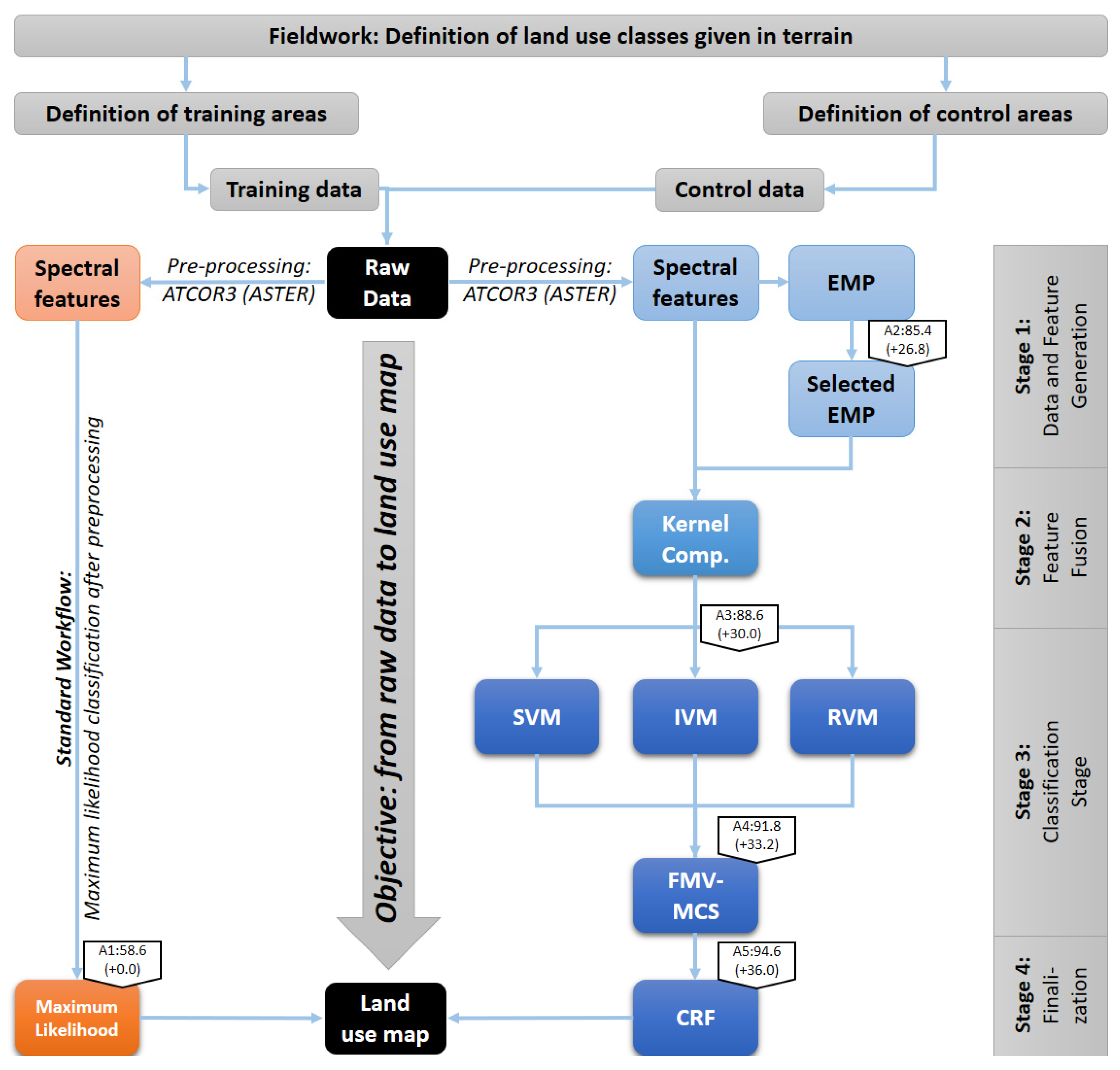
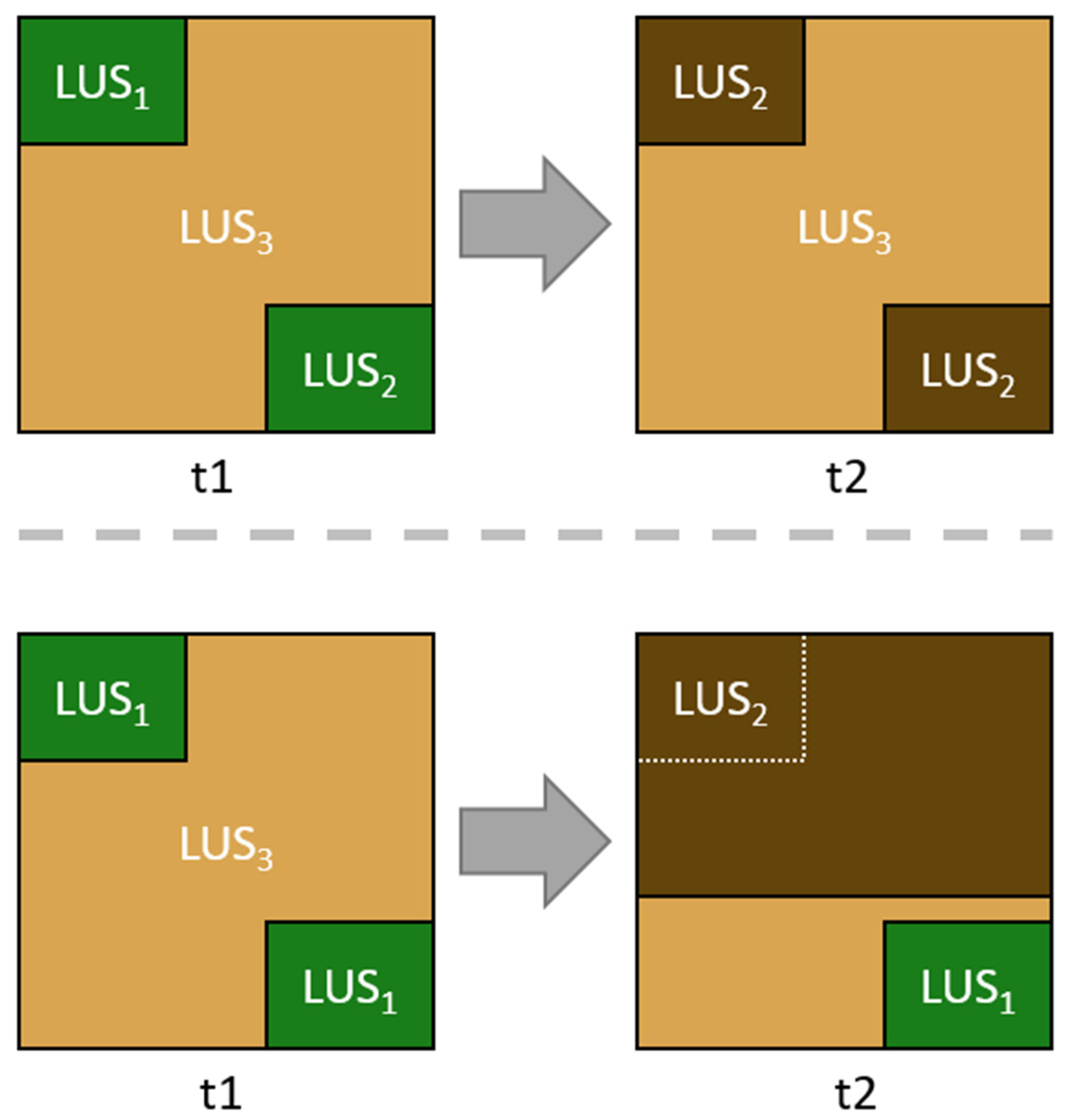
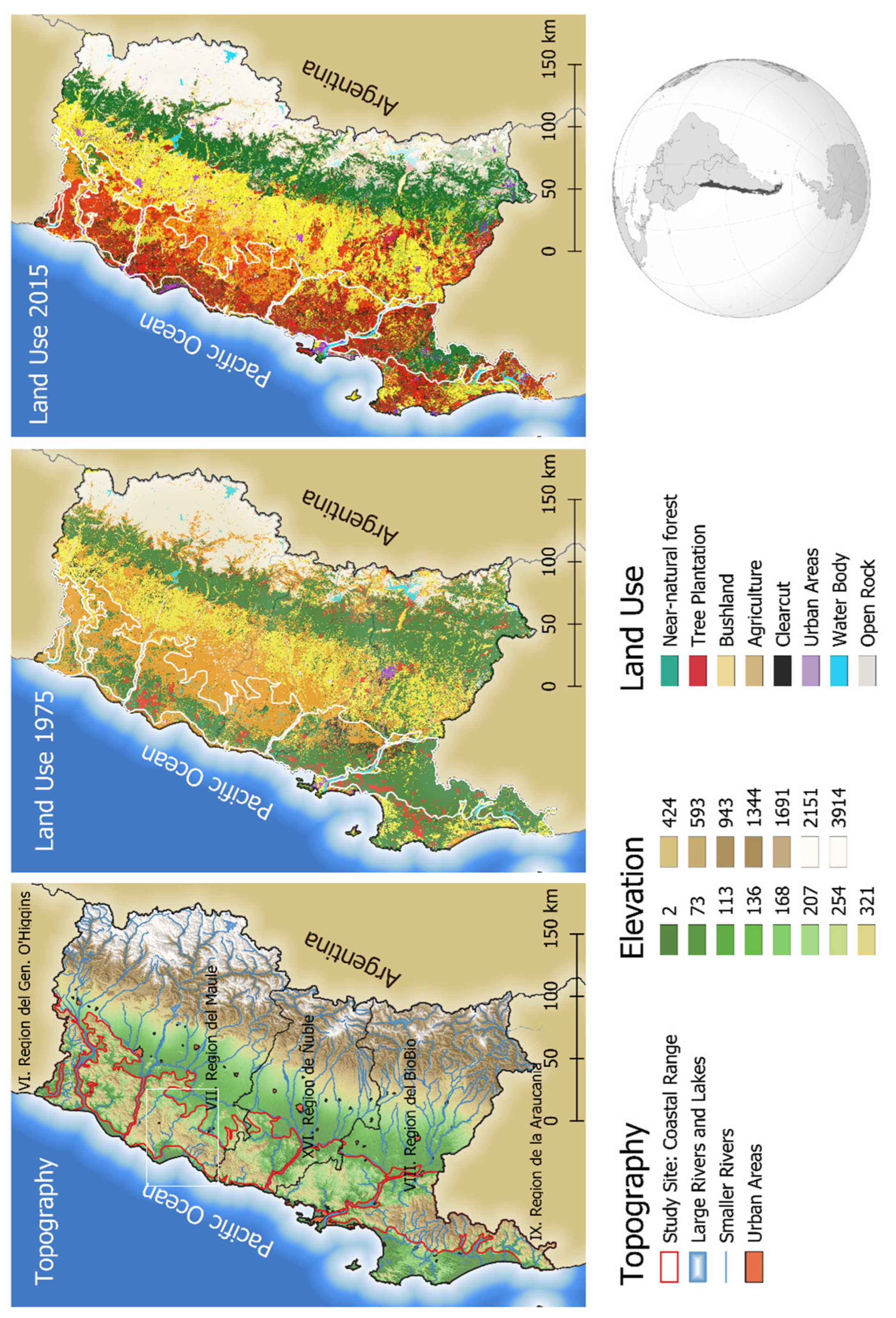

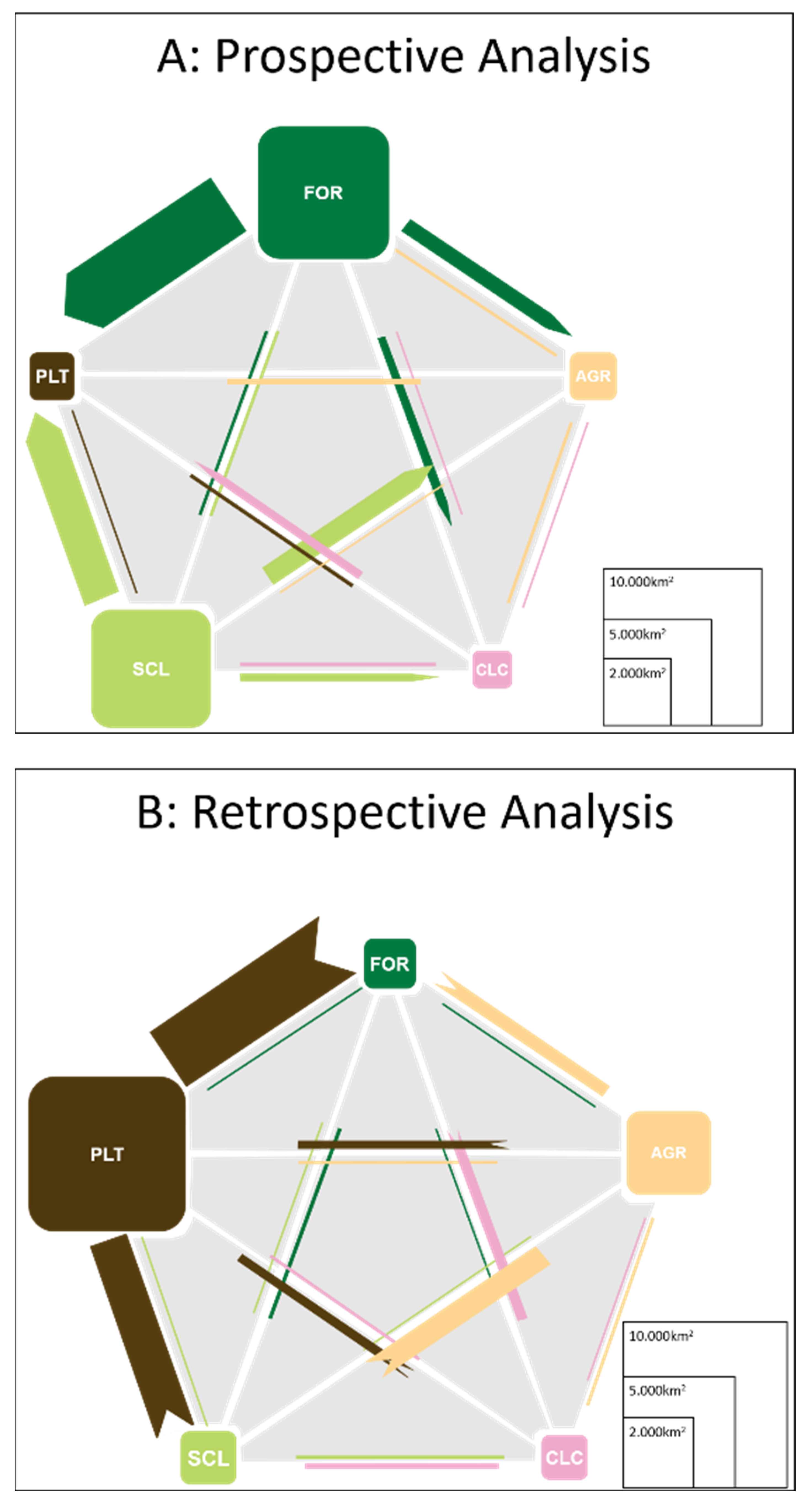

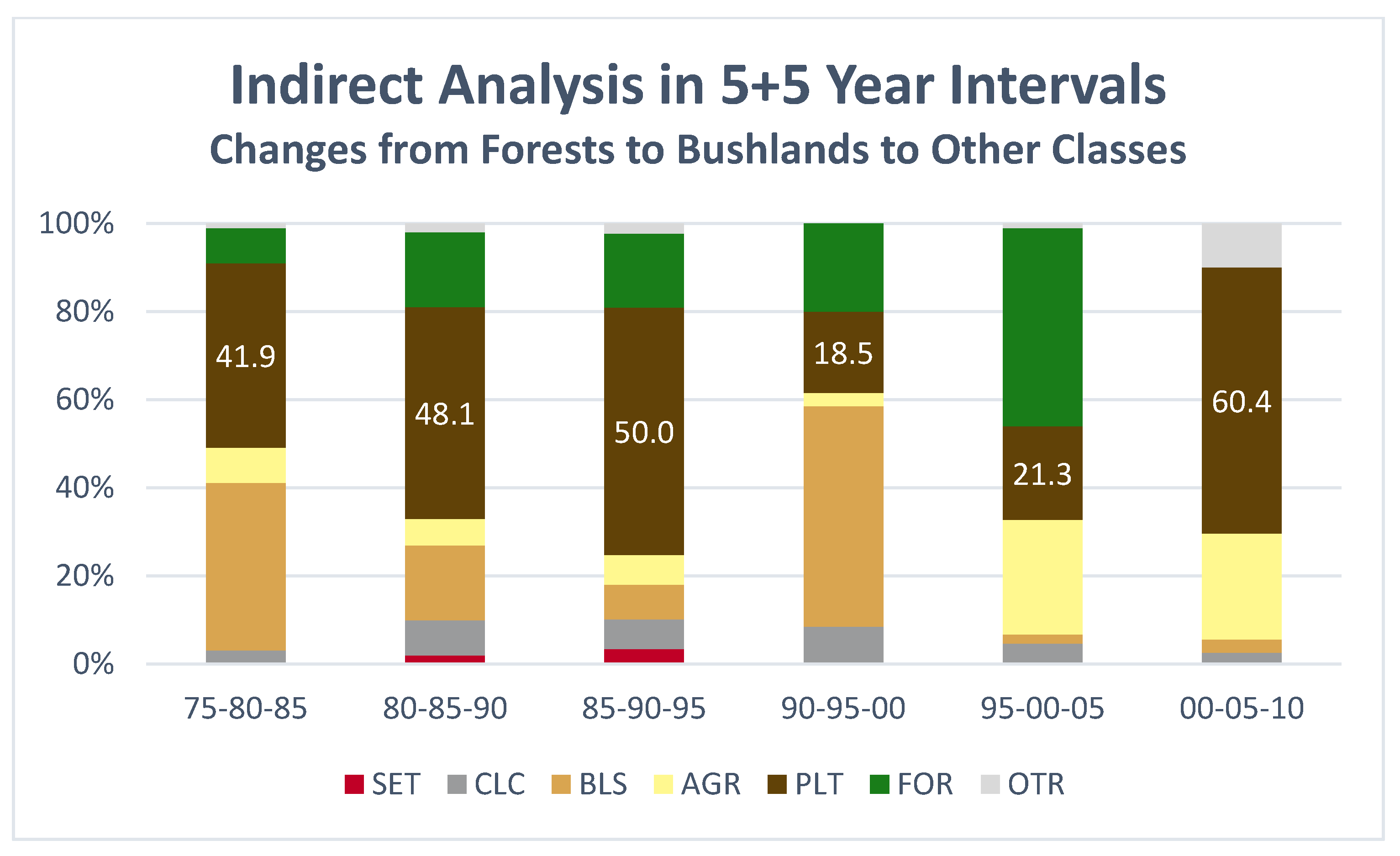
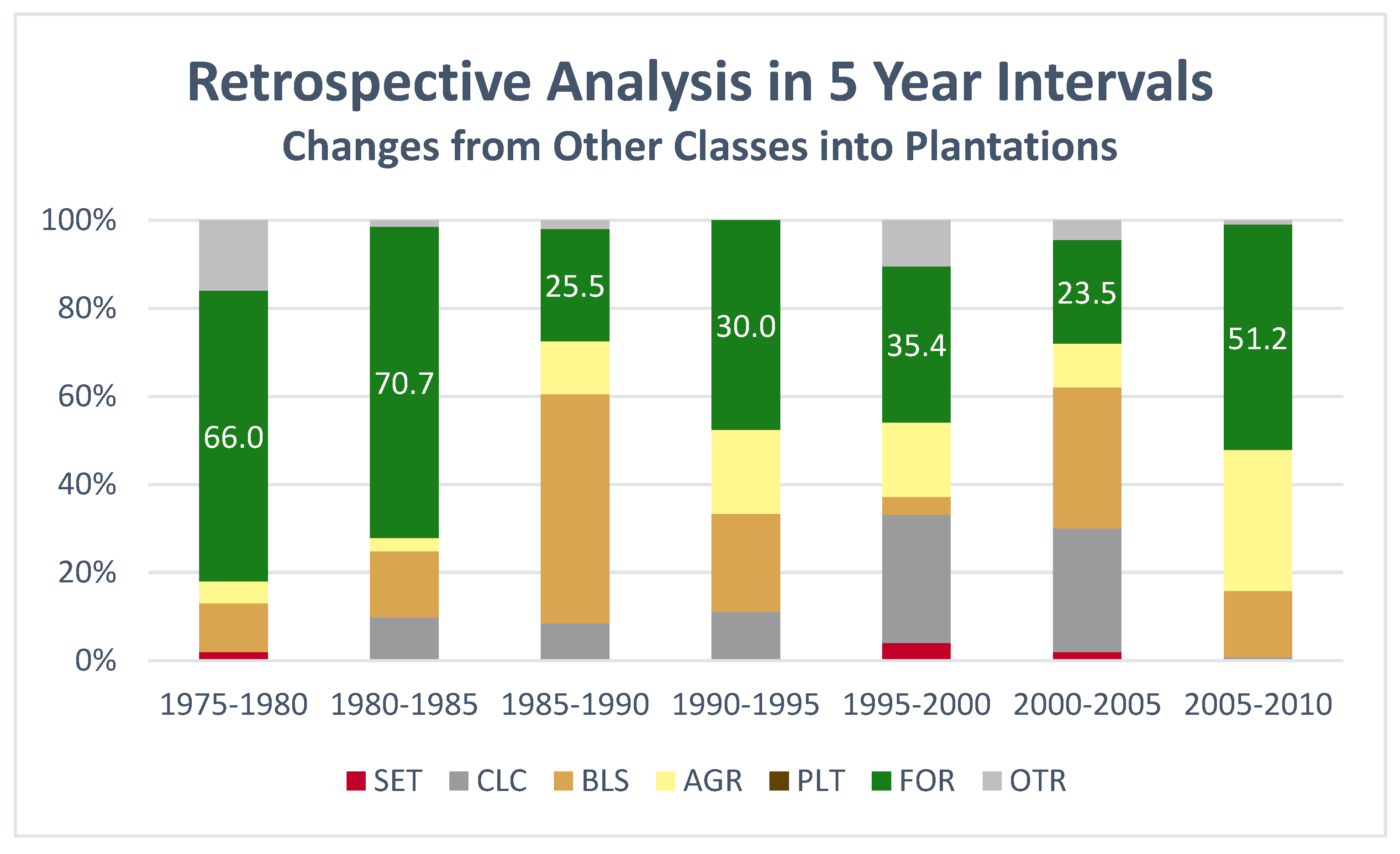
| Image Class | Name | Abbreviation | Class Color |
|---|---|---|---|
| 1 | Near-natural forests | FOR | |
| 2 | Tree plantations | PLT | |
| 3 | Agriculture | AGR | |
| 4 | Bushlands | BLS | |
| 5 | Clearcut | CLC | |
| 6 | Urban Areas | SET | |
| 7 | Waters | WAT | |
| 8 | Open Soils | OPS |
| Year | Data | Impr. | OAA | OSA | κ | minPA | minUA |
|---|---|---|---|---|---|---|---|
| 2010 | TM | 13.4 | 96.2 | 82.7 | 0.96 | 81.4 SET | 82.4 OPS |
| 2005 | TM | 1.6 | 85.6 | 84.1 | 0.80 | 66.1 SET | 33.3 AGR |
| 2000 | ETM+ | 7.7 | 97.8 | 90.1 | 0.96 | 77.7 SET | 93.2 WAT |
| 1995 | TM | 6.8 | 96.7 | 89.0 | 0.97 | 82.3 CLC | 91.2 WAT |
| 1990 | TM | 2.8 | 91.1 | 88.3 | 0.88 | 57.2 AGR | 40.7 BLS |
| 1985 | TM | 15.1 | 95.5 | 80.3 | 0.93 | 80.4 AGR | 63.0 WAT |
| 1980 | MSS | 6.0 | 92.8 | 86.8 | 0.90 | 27.8 CLC | 43.89 BLS |
| 1975 | MSS | 7.8 | 78.2 | 70.4 | 0.72 | 40.7 CLC | 59.2 FOR |
Publisher’s Note: MDPI stays neutral with regard to jurisdictional claims in published maps and institutional affiliations. |
© 2022 by the author. Licensee MDPI, Basel, Switzerland. This article is an open access article distributed under the terms and conditions of the Creative Commons Attribution (CC BY) license (https://creativecommons.org/licenses/by/4.0/).
Share and Cite
Braun, A.C. Deforestation by Afforestation: Land Use Change in the Coastal Range of Chile. Remote Sens. 2022, 14, 1686. https://doi.org/10.3390/rs14071686
Braun AC. Deforestation by Afforestation: Land Use Change in the Coastal Range of Chile. Remote Sensing. 2022; 14(7):1686. https://doi.org/10.3390/rs14071686
Chicago/Turabian StyleBraun, Andreas C. 2022. "Deforestation by Afforestation: Land Use Change in the Coastal Range of Chile" Remote Sensing 14, no. 7: 1686. https://doi.org/10.3390/rs14071686






